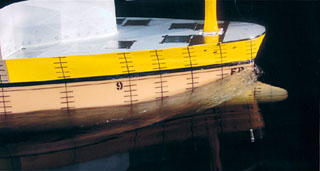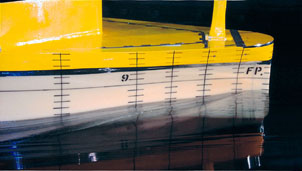New Design Enhances Propulsion of Medium-Speed Ships
May. 29, 2002
 |
 |
| Conventional LPG carrier | New SEA-ARROW design |
Kawasaki has drawn upon its design technology and shipbuilding expertise to develop the optimum bow shape for medium-speed marine vessels such as LPG carriers. The new design significantly reduces the bow wave resistance and enhances the ship's propulsive performance.
LPG carriers are required to have box-shape tanks arranged to the fore end of the hull for efficiency, as well as to enable faster speeds than oil tankers and bulk carriers. The carriers' length is limited to accommodate loading/unloading facilities. Thus, the greater weight in the bow generates high waves during navigation, and these act against the ship's forward movement and propulsive performance.
Kawasaki has solved these problems by designing a bow that dramatically reduces the wave-generated resistance inherent to LPG carriers. The new design, called the SEA-ARROW (Sharp Entrance Angle bow as an Arrow), retains the effect of the bulbous bow (bulb) while eliminating its protrusion from the bow itself.
The SEA-ARROW effectively halves the bow wave resistance, allowing the vessel to maintain the same speed as a conventional LPG carrier at 6 to 10% less horsepower, or a 0.3 to 0.5 knot speed increase when operating at the same horsepower. This development has led to a drastic reduction in fuel consumption and a shortening of ship-ping schedules. Kawasaki will adopt the SEA-ARROW design for five LPG carriers that have already been ordered, and also plans to integrate the design into all future LPG carriers.





